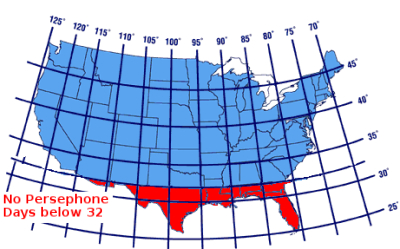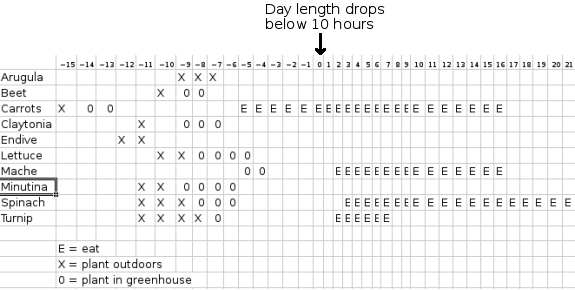
When to plant for a winter harvest
 After
years of experimentation, Eliot Coleman concluded that most plants stop
growing when the day length drops below 10 hours. After this
time, even if you protect your vegetables from the cold, they are
merely existing in a semi-hibernatory state.
After
years of experimentation, Eliot Coleman concluded that most plants stop
growing when the day length drops below 10 hours. After this
time, even if you protect your vegetables from the cold, they are
merely existing in a semi-hibernatory state.
Coleman coined the term
"Persephone Days" to refer to this deep winter
period of short days, which occurs from November 5 to February 5 on his
farm in Maine, from December 1 to January 10 in Charlotte, North
Carolina, and from about November 22 to January 19 here in southwest
Virginia. Those of you who are lucky enough to live south of the
32nd parallel have no Persephone Days and can keep your crops active
all winter if you play your cards right.
The trick to a long
winter harvest is to plant your crops at just the
right stage of the late summer and fall so that they are just shy of
maturity when the Persephone Days begin. Young plants are much
hardier than older ones, so planting dates are even more important in
the fall than in the spring --- planting too early is just as bad as
too late. You'll also need to pay close attention to succession
planting so that you'll have a continuous harvest throughout the winter
rather than a mass of lettuce one week and then no more for the rest of
the year. In effect, you're not extending the growing season,
just the harvest season.

I mocked up the chart
above based on information in The
Winter Harvest Handbook,
but converted it over to the type of planting calendar I find so
helpful. Rather than placing the last or first frost date
at 0 the way I do with my spring
planting and fall planting
calendars,
I've placed the onset of the Persephone Days there, but the chart is
otherwise read in the same manner. For example, Eliot Coleman's
Persephone Days begin November 5, so he plants his first arugula nine
weeks before, around September 3. Since my Persephone Days begin
on November 22, I should plant my first arugula on September 20.
 You'll also notice that
Coleman lists outdoors and greenhouse planting
times for many of his crops. As I mentioned in a previous post,
the greenhouse crops don't really need to be covered for a couple of
months in many cases, so his "greenhouse-planted" carrots seeded
fourteen weeks before his Persephone Days are actually planted in
the open, then have a greenhouse moved over top of them in late
October.
You'll also notice that
Coleman lists outdoors and greenhouse planting
times for many of his crops. As I mentioned in a previous post,
the greenhouse crops don't really need to be covered for a couple of
months in many cases, so his "greenhouse-planted" carrots seeded
fourteen weeks before his Persephone Days are actually planted in
the open, then have a greenhouse moved over top of them in late
October.
A word of warning ---
all of Coleman's data is for the far
northeast, so I expect I'll need to play around with these planting
dates by as much as a week or two to find the optimal planting times
for my climate. If you've already developed a planting calendar
for winter harvest in the southeastern or mid-Atlantic states, I'd be
curious to hear your specifics.
| This post is part of our Winter Harvest Handbook lunchtime series.
Read all of the entries: |
Want more in-depth information? Browse through our books.
Or explore more posts by date or by subject.
About us: Anna Hess and Mark Hamilton spent over a decade living self-sufficiently in the mountains of Virginia before moving north to start over from scratch in the foothills of Ohio. They've experimented with permaculture, no-till gardening, trailersteading, home-based microbusinesses and much more, writing about their adventures in both blogs and books.
Want to be notified when new comments are posted on this page? Click on the RSS button after you add a comment to subscribe to the comment feed, or simply check the box beside "email replies to me" while writing your comment.

I translated your table published in Romanian. Please give me your permission for publication. I delete the table if you do not allow. Thank you.(Google translate) Am tradus tabelul publicat de dvs. în limba romana. Va rog dati-mi acordul dvs. pentru publicare. Voi sterge tabelul daca nu veti permite. Multumesc.
http://nelucraciun.wordpress.com/2013/10/27/gradina-de-iarna-ziua-persefonei/